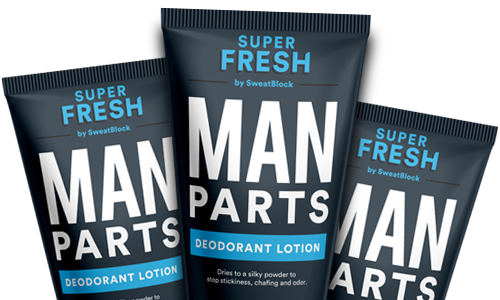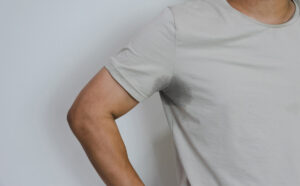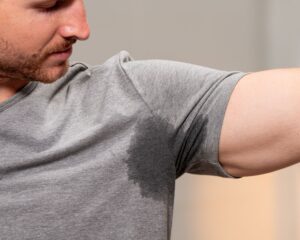Table of Contents
A romantic walk along a sandy beach, a scenic afternoon hike, or a stroll through the mall. They’re all great until it starts. First the itching. Then the burn. Then… the waddle.
That’s when you know you’re in trouble. Your thighs are chafed.
If you’re lucky, you’re at home with rash cream and a soft chair at arms reach. If you’re NOT so lucky (like most of us), you’re at the office or traversing a gargantuan college campus. Even worse, you could be wrapping up the last few miles of your morning run… OUCH.
This infamous burning and itching has many names: Chub rub, thigh chafing, sweat rash, groin rash, etc…
Honestly, who cares what you call it. We’re just interested in how to avoid it.
What causes thigh chafing?
Thigh chafing is something that most of us are hesitant to talk about, like sweating too much. It is so common that there are many ways to prevent it, or treat and soothe it if chafing has already begun. But first things first. What is thigh chafing?
Inner thigh chafing is caused by friction and sweat, and the repetitive rubbing of the skin. It’s annoying and can be extremely painful. It can occur where skin rubs against clothing or from skin-to-skin contact.
Chafing usually occurs in the inner thighs, upper thighs, groin area (especially for men), inner glutes, armpits, and even the nipples. You may also experience chafing where bra straps or backpack straps rub against your shoulders or back.
Chafing can also be caused by a build-up of salt residue when sweat evaporates. If sweat is allowed to dry while physical activity is continued, the salt left behind can accumulate and cause friction.
It helps to drink water and stay hydrated in order to reduce the salt content in your sweat. Other factors that increase the likelihood of thigh chafing are hot weather, sensitive skin, gritty sand from the beach, dust from hiking or running, and a previous skin irritation.
People who are very active or overweight are especially prone to body chafing. But even if you’re not an exercise nut or a sports enthusiast– and even if you’re not overweight or have big thighs– you’ve probably experienced chafing on the inner thighs.
The unpleasant results of inner thigh chafing include redness, itching, burning, blistering, and a painful rash. Left untreated, thigh chafing can also lead to fungal skin and even yeast infections. Serious thigh chafing can leave the skin raw and bleeding.
If you want to avoid chafing and irritation, focus on these 3 areas:
- Stay Clean
- Stay Dry
- Reduce Friction
With that in mind, here’s some tips to avoid the burn….
9 Ways to Prevent Thigh Chafing:

Heat makes us sweat. Seems like a no-brainer, right? Whether you’re living in the tropics or stuck in an office with the heat cranked too high, when your body temperature rises, you start to sweat.
Moreover, your balls can get extra sweaty since they live in a dark and warm environment. Keep in mind that sweating is your body’s natural air conditioning system, designed to cool your body temperature.
While it’s great that sweat keeps us cool, there’s no denying it causes some unpleasant side effects.
Sweat is usually fine when it has a chance to dry on the skin’s surface. The problem is, our balls don’t usually get a chance to fly free in the breeze. If you try it, in most places you’ll probably get arrested.
It’s highly doubtful that the sweat pooling in your crotch has a chance to dry properly. Instead, it hangs out down there, keeping your groin area full of moisture and forming the perfect habitat for odor-causing bacteria and fungi.
1. Stay Clean
This is an easy one. Shower daily and wear clean undies (yes, you should wear underwear if you want to avoid chafing ;). Daily activity will lead to a build up of dirt, salt and sweat in your thigh area.
This “thigh grime” causes that sticky feeling which leads to friction and chafing. Keeping your body clean is an easy first step to avoiding chafing between the thighs.
If you can’t shower after a run or an afternoon hike, use a shower body wipe to clean sticky sweat and dirt from between your thighs and groin area.
Wet clothing and sweaty thighs will get you chafed faster than you can say “whoah nelly!”. Fight chub rub and thigh burn by staying dry. Here’s a few secrets to staying dry down below…
2. Anti-Chafing Powder for Moisture Absorption
Moisture absorbing powders are perfect for keeping your inner thighs cool and dry. If you have a talc-free baby powder hanging around, it will do the trick. If you want something a little more… adult, check out some of our favorite body powder products below:
- Anti-Monkey Butt Powder for the Gals
- Anti-Monkey Butt Powder for the Guys
- Chassis Premium Body Powder
- Fromonda Body Powder
- Gold Bond Chafing Powder
With any body powder, you’ll need to apply multiple times a day to get the best results. If you want to go “au naturel”, you could toss some corn starch between your legs to get a similar outcome.
If you’re looking for something a little less messy and a bit more sophisticated than baby powder or body powder, you’ll like this next anti-chafing solution…
3. Body Powder Lotion (No mess application)
If baby powders are too messy for you, try a body powder lotion. What is a body powder lotion? It’s a lotion that goes on your skin like any other lotion, but then magically dries into a moisture absorbing powder. You get all the benefits of traditional chafing powder, but avoid the messy application.
PARDON THE INTER-RUB-TION!
4. Anti-Chafing Stick or Balm
Anti-chafing sticks are lubricants specifically designed to reduce friction. Anti-Chafing lubricants work by creating frictionless barrier on the skin that keeps your thighs and other areas from rubbing.
Thigh-chafing lubricants are easy to use and often come in the form of a deodorant-like stick or roll-on. We’ve listed the best anti-chafing sticks below…
5. Anti-Chafing Cream
Anti chafing creams are another kind of chafing lubricant designed to eliminate friction. Bikers and avid athletes will use chafing creams to prevent thigh chafing, and saddle sore. Some of the most recommended anti-chafe creams include…
Chamois Butt’r Anti-Chafe Cream: This cream was designed with avid cyclists in mind, but can be used by anyone. It lubricates areas prone to chafing and also soothes already chafed skin.
Blue Steel Sports Anti-Chafe Cream: This is another popular chafe cream for active individuals. It can be applied before, during and after activies to reduce friction, skin irritation, blisters and chafing.
Good ol’ Petroleum Jelly: Swabbing on a bit of petroleum jelly to your inner thighs is another inexpensive solution. You may find that petroleum jelly is too greasy and messy for regular use.
But in a pinch, and with no other solution available, it might just do the job. It will repel sweat and it certainly has proven lubricating properties. If you’re already a bit chafed, petroleum jelly can protect chapped areas if you need to keep moving.
Your choice of clothing can lead down a path of cool comfort -or- one of burning discomfort. To avoid the burn, avoid baggy clothing and clothing with seems that rub in areas prone to chafing.
Avoid wearing underwear with big seems or holes. You want to choose clothing that promotes dryness and reduces friction. Here are some anti-chafing clothing options…
6. Anti-chafing Underwear, boxers or briefs
Run-of-the-mill underwear isn’t designed for moisture wicking or friction fighting. If you want to protect your thighs from painful chafing, you’ll want to grab some anti-chafing underwear. This special underwear is designed to reduce moisture and friction (two of the leading causes of thigh chafing). Perfect for active individuals and athletes.
7. Anti-Chafing Thigh Bands (For the ladies)
Thigh bands are garter-like apparel expressly designed to prevent thigh chafing by covering chafe-prone areas. They come in two basic varieties– fancy and plain. The fancy variety is lacy and looks like the top of a thigh-high stocking. They are decorative and even resemble lingerie.
To use a thigh band, you measure your thighs where they touch to choose the right size. Sizing down a little will ensure a tight (but not too tight) fit. Most thigh bands are elastic and backed with silicone so they’re comfortable to wear.
The plain variety is made from lace-free microfiber. Whether you choose the fancy or the plain variety, thigh bands will prevent thigh chafing by placing a layer of slippery fabric protection between your thighs.
Many women wear them under every dress. Thigh bands are lightweight and comfortable, and people often forget they’re even wearing them. Women who have worn anti-chafing thigh bands say they work as advertised.
8. Anti-Chafing Shorts
Wearing shorts underneath outer clothing is an easy and effective way to prevent thigh chafing.
There are several options:
Bike Shorts: Lots of guys and even some women depend on bike cotton or spandex shorts as a thigh chafing remedy. Men often wear them under gym shorts when exercising. Many women wear bike shorts under their dresses and skirts. There are basic, constriction-free and inexpensive options. They may not be high fashion (I was tempted to say “thigh fashion”) but they do the job.
High Rise Shorts: High-rise or high-waisted shorts for women are designed to sit high on or above your hips– about 3 inches (remember mom jeans?). You don’t want them too tight and they should be made of a fabric that will breathe and not get hot. These high rise shorts also can’t be too long if they’re to be worn underneath a dress or skirt. Some look like a shapewear short, but they don’t fit as snugly as shapewear.
Compression Shorts: These are undergarments intended to help women look thinner. They’re mid-thigh shorts that will prevent thigh chafing. You’ll find that they are quite snug and extend further down the leg. You won’t have to keep pulling them down and they’re great for wearing under jeans.
Ultralight Seamless Shaping Shorts: You may be looking for a happy compromise between compression and non-compression shaping shorts. There are ultralight shorts that offer just such a solution. They will gently hug your thighs without making you feel like you’ve been squished into a giant pair of long, elastic bands.
9. Anti-Chafing Running Skirts (For the ladies)
Female runners can also purchase running skirts. Running skirts often have shorts that are built-in and will protect against inner-thigh chafing. Make sure they’re made of sweat-wicking fabric like nylon or spandex. Avoid cotton because cotton will absorb the sweat and hold it in place.
How to Treat Thigh Chafing
Let’s look at the answer in a few easy steps.
Cleanse
Once you’ve arrived home from the horse-back ride from hell, and your thighs look like a pair of boiled lobsters, the first step is to rinse them off in cool or lukewarm water and some very gentle soap. Avoid any soaps that will sting or send you into deeper agony. Find a mild, moisturizing pH-balanced variety. Don’t scrub.
Disinfect
You’ll want to kill any stubborn bacteria hiding out in your red, raw skin. Use a gentle antibacterial ointment like Neosporin or any of its generic or private label cousins.
Soothe
Now that you’ve cleaned and disinfected, how do you make the inner thigh pain and the rash on your legs go away? Lying spread eagle in front of a blowing fan will bring relief and soothe your irritated skin. But if you don’t have the luxury of spending the day reclined with a fan between your legs, try some Aloe vera gel. Avoid any Aloe product that contains artificial fragrance. You may also find success with coconut oil.
Keep ‘em Dry
You’ll need to keep your thighs dry for a couple of days while they heal. Wear breathable cotton undies, pajamas and other clothing for optimal chafing relief. You may want to delay that daily workout until the area has completely healed. Adding an additional sweat rash ain’t gonna help.
Apply Diaper Rash Cream
Okay, this doesn’t sound real grown-up, but your typical diaper rash cream containing zinc oxide which will provide welcomed soothing and antibacterial protection, too. You’ll want to avoid wearing any clothing that could show any tell-tale white smudges.
Wear Soft, Breathable Clothing
Now that you’re on the mend, wear comfortable, breathable clothing made of cotton.
When to See a Doctor
You should see your doctor if you have signs of skin infection (especially if you’re diabetic), if your skin is not healing, or if you have a thigh chafing rash and skin irritation that refuses to go away. Signs of infection include swelling, skin that’s hot to the touch, blood or pus coming from the chafed area, and redness radiating out from the chafing.
The Bottom Line
Now you know all there is to know (well, maybe not all, but a lot) about inner thigh chafing. Use anti-chafing products to prevent chafing and use these tips to get rid of thigh chafing once it’s happened. Whether it’s a constant concern, or only troubling when you’re exercising, you know what to do. Now, go ahead and do it, and don’t let skin chafing stop you. Happy trails!
You might also like...

10 Simple Hacks to Prevent Unwanted Boob Sweat
Table of Contents Sweltering summer weather. Intense workouts. First dates. Test jitters. Sweaty boobs. It’s true – lots of situations

How To Stop And Prevent Sweaty Balls
Table of Contents Guys, do you struggle with hot, smelly, sweaty balls? This topic might be uncomfortable, but it’s important.

How to Stop Groin Sweat: 10 Ways to Deal with Crotch Sweat
What’s in this Article? Let’s face it, groin sweat can lead to some rather embarrassing moments. When your sweat is

















